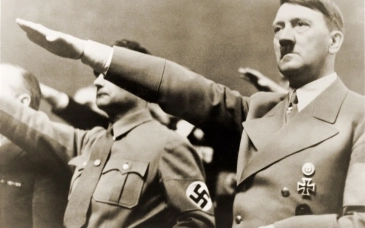Absolutism As A System
L'Etat, C'Est Moi
Date: 1998
Absolutism As A System
Unlimited royal authority, as advocated by Bossuet and Hobbes, was the
main characteristic of absolutism. It was demonstrated most obviously in
political organization but also served to integrate into government most
economic, religious, and social institutions. In this section, we will preview
this general pattern of absolutism before assessing its development within
specific European states.
Government And Religion Under Absolutism
Theoretically, the ruler made all major decisions in a typical absolute
state. Although this was not actually possible, chief ministers were
responsible directly to the monarch, and all of their actions were taken in
the sovereign's name. The monarch was officially the supreme lawgiver, the
chief judge, the commander of all military forces, and the head of all
administration. Central councils and committees discussed policy, but these
bodies were strictly advisory and concerned primarily with administrative
matter. All authority originated in orders coming down from the top and going
out to the provinces from the royal capital.
In conducting foreign policy, monarchs identified their personal dynastic
interests with those of their countries. They usually considered the
acquisition of foreign territory to be legitimate and pursued their objectives
in a competitive game of power politics with other monarchs. This competition
required a large military establishment, sometimes involving naval forces.
Rulers sought to form alliances against the most dominant foreign state,
giving little consideration to moral or religious principles. A concern for
the "balance of power" exemplified the new secular spirit in foreign
relations.
Local government was a concern to all aspiring absolute monarchs.
Wherever possible, they replaced traditional local authorities, usually feudal
nobles, with royal governors from other places. Where that could not be done,
local nobles were rewarded so they would support the crown. Sometimes, new
nobles were created and old land grants reassigned. Town governments were
often brought under royal authority through contacts between urban guildsmen
and the king's middle-class servants. Using such means as monopoly grants,
political favors, or bribery, monarchs extended their control over local law
and revenues.
Organized religion remained important under absolutism but lost its
independence of government. Instead of dominating politics, as they had done
earlier, churches - Protestant and Catholic alike - now tended to become
government agencies. Even in Catholic countries, such as France, the king
exerted more political control over the church than did the pope. Although
this had been true of earlier secular rulers, they had faced much more
religious opposition. After Westphalia, monarchs could deliberately use their
clergies as government servants, to enlist and hold popular support. Such
controlled churches exerted tremendous influence in support of absolute
monarchies, not only in the formal services but also in their social and
educational functions.
Mercantilism In The Structure Of Absolutism
In typical absolute monarchies, the regulation of state churches was
accompanied by a system of national economic regulations known as
mercantilism. Although it had originated earlier, with the emergence of modern
states, mercantilism was not adopted generally by European governments until
the late seventeenth century. The expansion of overseas trade, expenses
incurred in religious and dynastic wars, and the depression of the middle
1600s accentuated the trend toward mercantilism as states hoped to promote
prosperity and increase their revenues.
The system attempted to apply the capitalistic principle of
profit-seeking in the management of national economies. "Bullionism" was the
fundamental maxim of mercantilist theory. Proponents of bullionism sought to
increase precious metals within a country by achieving a "favorable balance of
trade," in which the monetary value of exports exceeded the value of imports.
The result, in a sense, was a national profit. This became purchasing power in
the world market, an advantage shared most directly by the government and
favored merchants.
Mercantilists believed state regulation of the economy to be absolutely
necessary for effecting a favorable balance. Absolute monarchies used
subsidies, chartered monopolies, taxes, tarriffs, harbor tolls, and direct
legal prohibitions in order to encourage exports and limit imports. For the
same purpose, state enterprises were given advantages over private
competitors. Governments standardized industrial production, regulated wages,
set prices, and otherwise encouraged or restricted consumer purchases.
Governments also built roads, canals, and docks to facilitate commerce.
Because mercantilists viewed the world market in terms of competing
states, they emphasized the importance of colonial expansion. They regarded
colonies as favored markets for home products and as sources of cheap raw
materials. Colonial foreign trade and industries were controlled to prevent
competition with the parent countries. In pursuing such policies, absolute
states needed strong military and naval forces to acquire colonies, police
them, and protect them from foreign rivals. Thus mercantilist policies often
extended beyond commercial competition to international conflict.
Class Structure Under Absolutism
The class structures of absolute monarchies were marked by clear
distinctions, precisely defined by law. Hereditary feudal aristocrats lost
status unless they acquired an official appointment from the monarch. Such
state nobles owed their privileges to their political service rather than
birth. They often came from merchant families; indeed, the state often sold
titles to wealthy commoners to provide income for the monarch. State nobles
served in public administration, inthe army, the church, or as attendants at
court, where they accented the royal magnificence. They usually received tax
exemptions, pensions, titles, and honors. Their legal rights, dress, and way
of life differed markedly from even wealthy non-nobles.
In contrast, commoners, including middle-class townspeople, paid most of
the taxes required by frequent wars and extravagant royal courts. Peasant
landholders usually owed fees and labor dues to local aristocrats. The poorest
peasants in western Europe were hired laborers or vagabonds; in eastern
Europe, they were serfs. Slavery was rare in western Europe, but provided a
major labor force on overseas plantations.
[See Noble And Peasant: The oppression of the peasantry is the subject of this
engraving, which compares the noble and the peasant to the spider and the fly.
The poor peasant brings all he has to the rich noble, who sits ready to
receive all the produce. From J. Lagniet, Recueil de Proverbes, 1657-63]
While tightening legal class distinctions, absolute monarchies also
further downgraded the status of women. The Reformation had offered some
opportunities for self-expression among women, and before 1650 many women had
assumed temporary positions of leadership. The situation changed after
Westphalia. Although a number of queens and regents were able to rule as
absolute monarchs, most aristocratic women could find recognition only as
Catholic nuns, writers, artists, salon hostesses, court gossips, or royal
mistresses, the latter gaining official status in this era. The status of
commoner women did not fall as much or as quickly, but the advent of early
capitalism and the decline of domestic economies was already excluding them
from many industries and enterprises in the latter seventeenth century.

